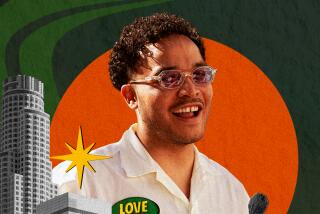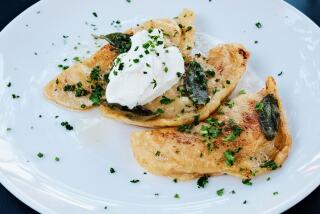Going Home
- Share via
On a bright Sunday in mid-December, Philip Westgren, a tall, 27-year-old film producer’s assistant, is on his way to one of his favorite places in Los Angeles--the IKEA store just off the 5 Freeway in Burbank. Westgren, like IKEA and his girlfriend’s Saab, is originally from Sweden, and whenever he feels especially homesick he takes a trip to the gargantuan home furnishings store for a taste of Swedish culture. Most Americans go to IKEA for relatively cheap, relatively stylish pieces for the home--build-it-yourself bookshelves, clever lamps, space-saving storage units. But Westgren, along with other displaced Swedes, goes to the store for the furniture names (“Leksvik,” “Ektorp” “Klang”), the Swedish meatballs in the cafe and the four varieties of pickled herring. For him, IKEA (pronounced ee-KAY-ah in Swedish) is the closest he can get to feeling like he’s home.
Westgren has lived in the United States for a little over seven years now, and the longer he stays the more he misses Sweden. He will tell anyone who will listen how beautiful his family’s summer home is, on the southwestern coast, overlooking an archipelago of hundreds of uninhabited islands. “Any season of the year it is gorgeous,” he says. “In summertime it is warm and you can swim in the ocean, and in the winter there is snow on the ground, the ocean is partly frozen over and it is beautiful in an entirely different way.”
Westgren came to the United States in 1997 to study film at Wesleyan University in Connecticut. He was, of course, already familiar with IKEA, a Swedish institution since 1958, and an American institution since 1985. But there was no IKEA in Connecticut when he was there, so if he was feeling desperate for Bilar, his favorite candy, which is sort of like gummy bears but shaped like cars, or knackebrod, the Swedish flatbread he likes to eat with cheese, he had to make the 2 1/2-hour drive to the one in Elizabeth, N.J. But since moving to Los Angeles he makes the trip from his home in Santa Monica to the Burbank IKEA about once a month. “I make up excuses to go all the time,” he says.
Once inside the enormous blue and yellow store--”The same colors of the Swedish flag,” he points out --Westgren stops immediately at a display. To the uninformed observer it looks like an average holiday dining room table, one that could be found at Crate and Barrel or Pottery Barn, with glitter strewn around the wine glasses and plates. But even this, Westgren says, is specifically Swedish. He grabs a pack of red paper napkins printed with a messy line drawing of a goat. “In Sweden this is traditional,” he says, pointing at the goat. “It’s tradition to have these little figures of goats made out of straw at the holidays. This is just a picture of it, but still. You see how they are exporting the culture.”
Although Westgren has some IKEA furniture in his home (a few bookshelves, a set of dressers in the bedroom), he is less interested in the large items than in the small familiar details scattered throughout the store. You wouldn’t notice them unless you knew where to look, and what you were looking at, but to Westgren they are everywhere. In a model living room, above a cream-colored couch, a large poster of a turbulent, rocky ocean catches his eye. “That’s not the exact landscape of where I’m from, but it’s close,” he says. In the chair department he points to a white pillow decorated with colorful tufts of string and explains that it is a traditional craft from the Lapland region in the north. In the housewares section, a simple wooden dish rack brings back memories of his childhood. “I’ve known this my whole life,” he says. “In every Swedish household they have this thing. Even my grandfather had this in his home.”
But the highlight of any IKEA trip for Westgren is the Swedish food market. Located beyond the cash registers and entirely irrelevant to the casual shopper, it is the only place in Los Angeles where Westgren can buy all of his favorite Swedish foods. There is herring in mustard sauce, and lingonberry jam. There are jars of lumpfish caviar to mash up with avocado, sour cream and sliced onions. There is a mix for glogg, the hot holiday drink made with wine. There is tunnbrod, soft Swedish thin bread, to eat with a Swedish cheese called Prastost, and lots of Swedish desserts that all seem to involve marzipan. And of course there are Swedish meatballs, which Westgren always keeps in his freezer. “In Sweden people really do eat Swedish meatballs all the time,” he says. “If you don’t really feel like cooking, it’s like, ‘Let’s make some meatballs.’ It is totally cheap food.”
Hanging on the wall across from the food market are two 8-foot-high photographs of different locations in Sweden. On this Sunday the city of Stockholm and the region of Smaland are featured, but for the past several months there was a photo of Bohuslan, where Westgren grew up. “The picture could have been taken in our village,” he says. “The first time I saw it I was so excited. I was entranced by it. It was like looking at the real thing. And they put up these little descriptions of the lifestyle of the area next to them that are totally sentimental. For my village they talked about late summer evenings when it’s 10 o’clock at night and the sun has not gone down yet and looking out over the ocean as the sun sets,” he says wistfully. “It really feels like far away from here. It is far away from here, you know?”
Outside the store, under a white tent, there is a small Swedish Christmas market, and Westgren runs into three Swedish expats who have driven an hour and a half from Santa Barbara to pick up a few holiday items. Helena Joyce, who has been living in the United States for 30 years, is buying a few packs of the straw goat napkins to send to her daughter, and Meit Blomst and Gunnar Fredlund are looking for glogg and Advent candles, which they say everybody uses in Sweden before Christmas. They admit that, like all their Swedish friends, they make the trek to Burbank at least four times a year.
“It’s like Americans, if they have been abroad for a while they go to McDonald’s,” Fredlund says. “We go to IKEA.”
More to Read
Sign up for The Wild
We’ll help you find the best places to hike, bike and run, as well as the perfect silent spots for meditation and yoga.
You may occasionally receive promotional content from the Los Angeles Times.







